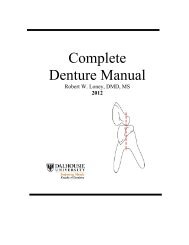RPD Manual 11 - Removable Prosthodontics - Dalhousie University
RPD Manual 11 - Removable Prosthodontics - Dalhousie University
RPD Manual 11 - Removable Prosthodontics - Dalhousie University
Create successful ePaper yourself
Turn your PDF publications into a flip-book with our unique Google optimized e-Paper software.
Surveying, Path of Insertion, Guiding Planes - 18<br />
B. Interferences - A path of insertion must be selected so that the prosthesis may be inserted<br />
and removed without encountering tooth or soft tissue interferences. Tooth interferences are<br />
usually encountered where rigid elements of the partial denture would require placement in<br />
areas of undercut. Since rigid elements do not flex, such a partial denture will not seat.<br />
Tooth interferences are often encountered in the bucco- or linguo-occluso-proximal point<br />
angles, where the height of contour is high and where rigid portions of the clasp assemblies<br />
must be placed.<br />
Since only the terminal end of the retentive arm<br />
flexes (circled area), the clasp on the left will<br />
lock on the cast. The rigid portion of the clasp<br />
will not release from the undercut. The clasp on<br />
the right will release since only the flexible tip is<br />
in the undercut.<br />
When soft tissue undercuts exist (i.e. mandibular tori, residual ridge undercuts), the rigid<br />
denture base can cause abrasion, irritation and /or ulceration as it is forced over the tissue.<br />
As such, a path of insertion that involves interferences should only be selected if the<br />
interferences can be eliminated by tooth preparation or reasonable blockout of the master<br />
cast. If the interferences cannot be eliminated or minimized, then a different path of<br />
insertion must be considered, even if less desirable guiding plane and retentive areas must<br />
be selected.<br />
Soft tissue undercuts require that the tissue be impinged<br />
upon as the major connector or denture base passes over it.<br />
If a large undercut is blocked out, the connector or base will<br />
be remote from the tissue and collect food and debris.<br />
C. Esthetics. A path of insertion should be selected to provide the most esthetic placement of<br />
artificial teeth and the least amount of visible metal on the abutment teeth. Ensure that the<br />
retentive undercut and the height of contour are not placed too far occlusally, so that the<br />
retentive clasp and that anterior proximal plates are close to the gingival contours making<br />
these components as inconspicuous as possible.<br />
D. Guiding planes. Guiding planes are flat surfaces prepared on abutment teeth. Flat, rigid<br />
elements of the partial denture (bracing elements and proximal plate minor connectors) fit<br />
against these surfaces to ensure that a partial denture seats along one path of insertion.<br />
Guiding planes are used to control and limit the directions of movement of a removable<br />
partial denture as it is being inserted, removed or while it is in function. To do this, bracing<br />
elements or proximal plates should, whenever possible, be the initial portions of the<br />
partial denture to contact the abutments. In this way, the teeth are stabilized from the<br />
potential moving forces as retentive elements of direct retainers flex over the heights of<br />
contour into the retentive undercuts.















